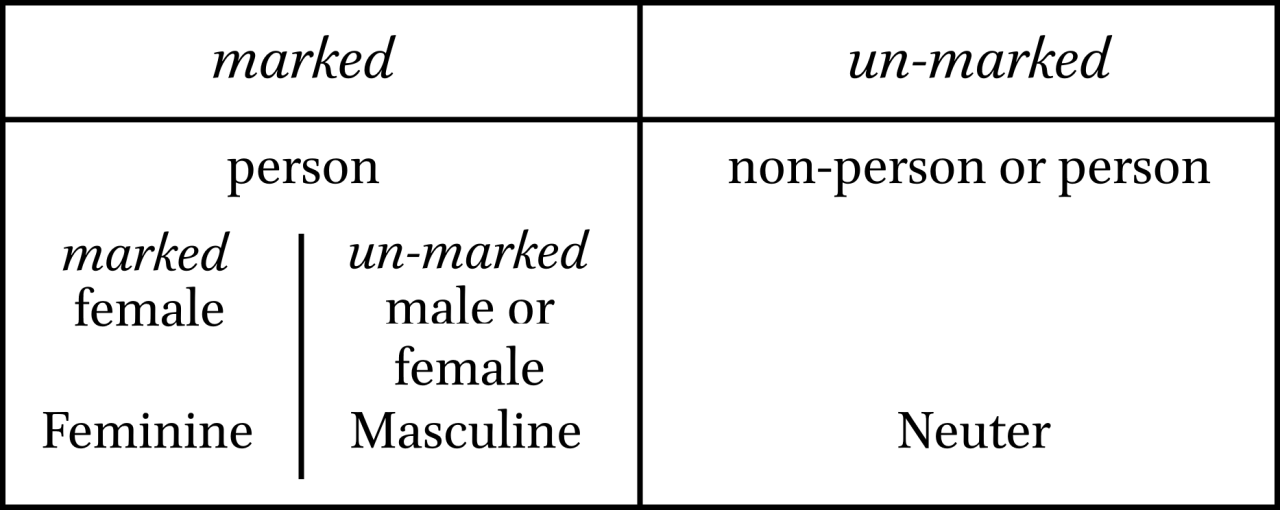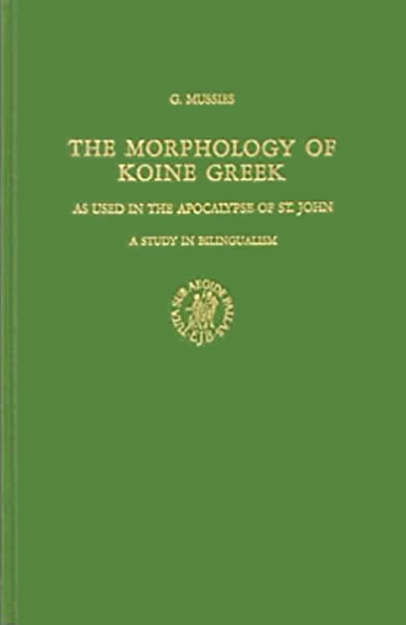Part I: Mussies (1971) on Greek gender
Part II: Gender as classification
Part III: Gender marking within the noun phrase
Part IV: Gender marking in the clause, sentence & discourse
Part V: Reconciling two approaches
Part VI: Toward a cognitivist view of Greek gender
Gerhard Mussies published a morphosyntax of post-Classical Greek in 1971 that’s often overlooked because of the appearance of its seemingly narrow focus on the Revelation of John. But Mussies has a clear grasp of method in grammatical analysis and, as a result, wrote a fairly detailed grammar of post-classical Greek morphosyntax, which he then used as a point of comparison with the grammar of John’s Apocalypse. One salient and striking point of analysis involves his discussion of grammatical gender, which is a step above what we find in most grammars written in English. Typically Greek gender is treated in two primary ways (and always cursorily).
- Lexical: grammatical gender functions as an inherent property of the noun as a lexical classifier system.
- Agreement: grammatical gender specifies syntactic relationships between subordinate elements like adjectives and participles to a head noun by agreeing with the inherent gender of the noun.
Mussies’ (1971) discussion suggests a more complicated situation for how gender is assigned to normally subordinate grammatical categories like adjective and participles. He writes:
In independent adjectives, the value of the feminine categories consists in the positive reference to a female person (we use the words feminine and masculine for the categories, the words female and male for the sexes) e.g. Odyssey ε, 212-213, ἐπιεὶ οὔ πως οὐδε ἔοικε/θνητὰς ἀθανάτῃσι δέμας καὶ εἶδος ἐρίζειν. From the New testament we know only instances that happen to contain participles or numerals: Matt. XXIV 41 δύο ἁλήθουσαι ἑν τῷ μύλῳ μία παραλαμβάνεται, καὶ μία ἀφίεται, and Luke I 45 μακαρία ἡ πιστεύσασα (στεῖραι in Luke XXIII29 μακάριαι αἱ στεῖραι is perhaps not an adjective).
The gender value of the masculine categories is the positive reference to a person, but this person may be male or female. Often the context gives a clue for us to decide whether woman (women) or man (men) is (are) spoken about, but not always so; in e.g. Apc. XXII 11 ὁ δίκαιος δικαοσύνην ποιησάτω ἔτι καὶ ὁ ἄγιος ἁγιασθήτω ἔτι both sexes are meant indiscriminately. The masculine category is therefore unmarked as opposed to the feminine.
Mussies 1971, 123; my emphasis.
It is that last line that’s probably most important here: “The masculine category is therefore unmarked as opposed to the feminine.” Let us break down the implications of this. When an adjective or a participle is used as a substantive on its own and does not receiving its gender morphology from agreement with another noun, gender marking is defined by semantic criteria, rather than syntactic (agreement) or lexical (inherent).
- When a substantive adjective/participle appears in the feminine gender, it can only have a female person referent.
- When a substantive adjective/participle appears in the masculine gender, it can refer to a person of any biological sex. In these contexts with such substantives, the masculine gender does not refer to solely to males, but rather personhood: regardless of biological sex.
- When a substantive adjective/participle takes the neuter grammatical gender, it can refer to any kind of entity/participant regardless of their status as a person.
The relationship here, as Mussies presents it, is asymmetrical. The feminine gender has the narrowest possible domain of reference. The masculine gender covers a larger domain that subsumes person, including women. The neuter gender may be used to refer to anything.
Mussies presents these distinction in the form of a table, included below, in terms of Jakobsonian’s markedness.

And if we take our time to find them, we can find examples that fit this pattern playing out in the New Testament.
Feminine Gender
- δύο ἀλήθουσαι ἐν τῷ μύλῳ, μία παραλαμβάνεται καὶ μία ἀφίεται.
Two will be grinding at the mill. One will be taken and one will be left (Mt 24:41). - διὰ δὲ τὰς πορνείας ἕκαστος τὴν ἑαυτοῦ γυναῖκα ἐχέτω, καὶ ἑκάστη τὸν ἴδιον ἄνδρα ἐχέτω.
But because of sexual immorality, each man should have his own wife and each woman her own husband (1 Cor 7:2). - εἴ τις πιστὴ ἔχει χήρας, ἐπαρκείτω αὐταῖς, καὶ μὴ βαρείσθω ἡ ἐκκλησία, ἵνα ταῖς ὄντως χήραις ἐπαρκέσῃ
If any believing woman has widows, she must help them and the church must not be burdened, so that it can help those who are truly widows (1 Tim 5:16).
Here in examples (1-3), the quantifiers μία, ‘one’, and ἑκάστη, ‘each’, and the adjective πιστὴ, ‘believing one’ are all substantives. In (1) the feminine gender both specifies that the referent of each μία is female and also that each is co-indexed with the quantifier δύο. The only reason the sex of the two at the mill are known is from the grammatical gender of the instances of μία. In example (2), ἑκάστη functions contrastively with ἕκαστος, with the English overly using lexical items ‘man’ and ‘woman’ where the Greek only depends on morphology. Then (3), Paul refers to Christian women who support widows in their lives simply with the feminine form of the adjective πιστὴ ‘believing’.
Masculine Gender
- πολλοὶ δὲ ἔσονται πρῶτοι ἔσχατοι καὶ οἱ ἔσχατοι πρῶτοι
But many who are first, will be last and the last will be first (Mk 10:31). - καὶ ἤκουσαν οἱ περίοικοι καὶ οἱ συγγενεῖς αὐτῆς ὅτι ἐμεγάλυνεν κύριος τὸ ἔλεος αὐτοῦ μετʼ αὐτῆς, καὶ συνέχαιρον αὐτῇ.
Her neighbors and relatives heard that the Lord had shown great his great mercy with her and they rejoiced with her (Luke 1:58). - πολλοὶ μὲν οὖν ἐξ αὐτῶν ἐπίστευσαν, καὶ τῶν Ἑλληνίδων γυναικῶν τῶν εὐσχημόνων καὶ ἀνδρῶν οὐκ ὀλίγοι.
Many of them believe and not a few prominent Greek women and men (Acts 17:12)
The masculine gender is consistently used for mixed gender groups, including women, as illustrated implicitly and explicitly in examples (4-6). The masculine gender is also used for individual men and non-mixed groups of only men, of course, but the relationship between gender and biological sex in a language like Greek is problematic. Gender in such languages is a classificatory system, not a marker of biological sex.
Neuter Gender
- ἄνδρες Νινευῖται ἀναστήσονται ἐν τῇ κρίσει μετὰ τῆς γενεᾶς ταύτης καὶ κατακρινοῦσιν αὐτήν· ὅτι μετενόησαν εἰς τὸ κήρυγμα Ἰωνᾶ, καὶ ἰδοὺ πλεῖον Ἰωνᾶ ὧδε. 42 βασίλισσα νότου ἐγερθήσεται ἐν τῇ κρίσει μετὰ τῆς γενεᾶς ταύτης καὶ κατακρινεῖ αὐτήν· ὅτι ἦλθεν ἐκ τῶν περάτων τῆς γῆς ἀκοῦσαι τὴν σοφίαν Σολομῶνος, καὶ ἰδοὺ πλεῖον Σολομῶνος ὧδε
The people of Nineveh will rise up at the judgment with and condemn it, because they repented at the proclamation of Jonah, and see, one greater than Jonah is here! The queen of the South with rise up at the judgment with this generation and condemn it, because she came from the ends of the earth to listen to the wisdom of Solomon, and see, one greater than Solomon is here! (Mt 12:41–42).
In example (7) , Jesus is the referent πλεῖον (one greater) than Jonah and of Solomon. Mussies describes this pattern he seems in terms of an asymmetrical markedness.
Mussies provides a discussion of that as well, which shows that he follows Roman Jakobson & Joseph Greenberg’s perspective of these terms (cf Greenberg 1966).
[I]n describing the semantic differences between two opposed series of words one can usually consider either of the values as positive i.e. positively expressing a certain notion, whereas the opposed value is neutral i.e. expressing indifference with regard to the positive value of the other category. In practice, this means that according to context the value of the unmarked member may imply the absence of the notion expressed by the positive value, or express a notion which does not exclude that of the positive value. Semantic oppositions, therefore, are not polar, not like “X vs. Y” which are then exclusive of one another, but but rather like “X vs. O” i.e. “X vs. (X plus Y)”. An example is furnished by the opposition between the vocative and the nominative e.g. δοῦλε vs. δοῦλος, πόλι vs. πόλις, etc. Of the vocative the value always implies the addressee, the person spoken to; the value of the nominative, however, is neutral: contextually it may indicate the addressee (nom. “used as a vocative”), or not (nom. used with 3rd p. verb); it is unmarked as opposed to the vocative.
Mussies 1971, 72-73; my emphasis.
Now, there are a few important observations worth making here. First: anyone who wants to make theological claims about a classificatory gender system vis-a-vis biological sex (male and female), but cannot integrate the neuter gender to those claims should pause. Grammar is not your playground for your theology. Second, the patterns that Mussies describes in the examples I provide and the examples he provides do not actually fully explain gender marking in the larger set of substantive adjectives and participles.
In the next part of this discussion, I want to examine the larger set of data for substantive adjectives and participles. I think we can make some better and more comprehensive generalizations about the Greek gender system. These issues matter for (1) how we understand Greek and (2) how minority languages deal with difficult questions of reference and anaphora resolution for their own classificatory noun systems.
Works cited
Greenberg, Joseph. 1966. Universals of language. 2nd edition Cambridge, Mass.: MIT Press.
Mussies, Gerhard. 1971. The morphology of Koine Greek as used in the Apocalypse of St. John: A study in bilingualism. Novum Testamentum supplements 27. Amsterdam: Brill Academic.
